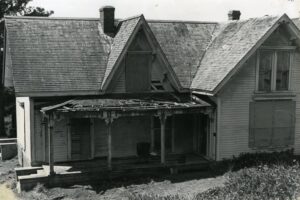The Kelley House may be one of the jewels in Mendocino’s quaint Victorian crown, but it took a lot of work over almost fifty years by many generous people to make it look this good. When Beth Stebbins and Dorothy Bear first clapped eyes on it in 1969, it was dilapidated and, in Stebbins’ words, “very unprepossessing.” A rental property since pioneer Eliza Owen Kelley followed her husband William to the grave in 1914, the house had not been well maintained and gave little hint of having once been the elegant home to one of Mendocino’s first families.

An April 1975 photograph taken from the Kelley House water tower showing the east side of the house in a state of disrepair and just before the restoration project began. Despite the obvious dilapidation, the well built house’s roof line was still level.
Bear, a librarian, and Stebbins, an accountant and amateur photographer, retired to Mendocino from Palm Springs and became interested in the architecture of the old buildings and the town’s cultural history. Women of immense determination and energy, they started collecting photos and objects, interviewing old-timers such as Nannie Escola and thinking about acquiring and restoring the Kelley house.
They began by publishing “A Walking Tour of Mendocino,” and then “Mendocino: Book One” in a second-floor space they rented from Warren and Dora Zimmer at Gallery Fair in the Odd Fellows Hall. Then in 1973 they established Mendocino Historical Research, Inc. (MHRI) to “collect, document, and publish the history of Mendocino City, California, and the coastal areas of Mendocino County.”
Late in 1974 they learned of plans to purchase the old Kelley residence, demolish it, and build a motel and restaurant on the site. That spurred them into a fundraising drive that elicited donations from local people and organizations, and grants from both federal and state governments. After that failed to raise enough to purchase it, they accepted an impossible-to-refuse offer from Robert O. Peterson, the wealthy Jack in the Box founder and philanthropist.
Peterson had a soft spot for Mendocino because his grandfather had worked for 22 years in the Mendocino mill. He was restoring the Mendocino Hotel several doors down Main Street. He bought the large parcel that held both the Kelley house and the old Kelley Store located on the corner of Lansing and Main, split the lot, and he kept the corner property then deeded the parcel with the House to MHRI in April of 1975 with two provisos: 1) the hotel would retain the water rights to the well under the Kelley water tower, and 2) the house was to be used “for preservation purposes, and not for any commercial gain.”
He also gifted them $10,000, which was added to the other donations to begin the restoration. The newly constituted Restoration Consulting Committee directed an engineer to survey the house inside, outside, and under. From his report the Committee developed a to-do list that included foundation repair, shoring up the upstairs floor, removing the fireplace and partitions in the front room, moving plumbing pipes from the outside walls to the inside, re-wiring the whole place, drilling a new well, and installing a new furnace because the coal-burning fireplace was going away.
Architect Sam Waldman drew up necessary plans, local contractor Francis Jackson was engaged, and work started in May of 1975. As the work progressed, the rooms downstairs were used as office and meeting spaces, and the growing collection of historical items were stored upstairs.
To protect the vulnerable structure during this period, an apartment for caretakers Karen and Josh Lowell was created in what had been the kitchen wing and is now the research office. Volunteer gardeners, including Frances Casey, worked on and off for years to get rid of the tangles of blackberries and weeds that had overrun the garden areas.
It took almost ten years to complete the work on that initial to-do list. In 1984, Mendocino Historical Research (later renamed Kelley House Museum) kicked off another fund drive to complete the downstairs interior work and restore the upstairs bedrooms. That October, the museum held its first Treasure Sale, which would become a Mendocino fall tradition that lasted for almost 30 years—almost as long as it has taken to bring the house to where it is today. In 1993, an archival vault was constructed on the west end of the office to provide climate-controlled space for the ever-growing collections or photos, objects, and reference materials.
In the past three years, the Community Foundation of Mendocino County and private donors have provided much-needed funding to repaint the house and replace the leaky roofs on the house and vault. Currently, another generous resident, Alida Morzenti, is underwriting a new picket fence on the Main Street side of the pond. The next big project is rehabilitation of the tongue-in-groove floors on the beautiful east and west porches. The flooring was originally redwood, and we must replace like with like.
If you’d like to join the many Mendonesians and their friends who have lovingly donated time and money over the last four decades to the ongoing community obligation to preserve this cultural resource, please contact Anne Semans our director. Phone 707/937-5791 or email [email protected]
Our “Kelley Family Celebration” series continues next week with the story of William Henry Kelley, a Canadian ship carpenter who took a job on a leaking ship in 1852 and ended up owning the Mendocino peninsula.